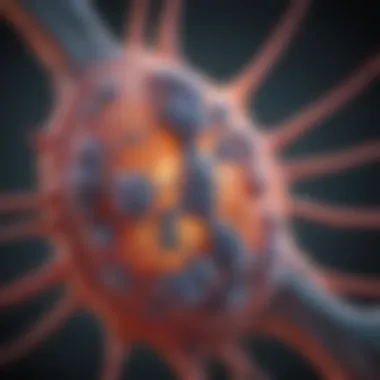Exploring Breakthroughs in Lung Cancer Treatment


Intro
Lung cancer is a significant challenge in modern medicine. It remains one of the leading causes of cancer-related deaths globally. Recent advancements in treatment options offer hope, especially with the emergence of a new drug. This drug has shown potential to change the treatment landscape for lung cancer patients. By understanding its mechanism of action and the results from clinical trials, we can better appreciate its implications for patient care. This article aims to provide a detailed examination of this new drug and its place within the broader context of lung cancer treatment.
Research Overview
Summary of Key Findings
The development of this new lung cancer drug arises from a complex understanding of cancer biology and therapeutic targets. Researchers have identified specific pathways involved in tumor growth and survival. This new drug acts on these pathways, offering a novel approach not only to inhibit tumor growth but also to improve patient outcomes. Clinical trial results have indicated promising efficacy, with many patients experiencing significant tumor reduction and improved survival rates. Moreover, preliminary safety profiles suggest manageable side effects, which stand in stark contrast to traditional chemotherapy.
Relevance to Current Scientific Discussions
This new treatment aligns with ongoing discussions in oncology regarding the need for targeted therapies. With current treatments, a substantial portion of lung cancer patients still do not respond adequately. This unmet need in lung cancer treatment highlights the importance of innovations like this new drug. Furthermore, the findings regarding this drug contribute valuable insights to the debate around personalized medicine, emphasizing how understanding individual tumor characteristics can lead to more effective treatments.
"The landscape of lung cancer treatment is rapidly evolving, and innovative therapies will play a crucial role in improving patient care."
Methodology
Research Design and Approach
The research underlying this new lung cancer drug encompasses a rigorous design. Researchers have utilized both preclinical studies and randomized controlled trials to evaluate the drug's effectiveness. These multi-phase trials provide robust data that support the drug's anticipated benefits for patients.
Data Collection and Analysis Techniques
Data collection involved multiple techniques, including biomarker analysis and patient response assessments. Statistical methods were applied to analyze the data to ensure that results were both valid and reliable. By employing such comprehensive methodologies, researchers have laid a solid foundation for the conclusions drawn about the drug’s efficacy and safety.
Preface to Lung Cancer
Lung cancer remains a significant global health issue, representing one of the leading causes of cancer-related deaths worldwide. Understanding the intricacies of lung cancer is vital for both medical professionals and those affected by this disease. This section seeks to provide foundational knowledge that sets the context for discussing innovative treatments and emerging therapies. Insights gained from exploring this topic uncover necessary considerations in treatment approaches and the ongoing quest for improved patient outcomes.
Definition and Types
Lung cancer is defined as the uncontrolled growth of abnormal cells in one or both lungs. These cells can form tumors that obstruct respiratory pathways and compromise lung function. Two primary types exist: non-small cell lung cancer (NSCLC) and small cell lung cancer (SCLC). NSCLC accounts for about 85% of lung cancer cases and is often categorized into subtypes such as adenocarcinoma, squamous cell carcinoma, and large cell carcinoma. SCLC, on the other hand, tends to grow more rapidly and has a higher likelihood of spreading to other parts of the body. Understanding these distinctions aids in tailoring treatment strategies and improves prognostic outcomes for patients.
Statistics and Prevalence
The statistics surrounding lung cancer are sobering. According to the World Health Organization, lung cancer is responsible for an estimated 1.8 million deaths annually. It primarily affects older adults, with the median age at diagnosis typically being around 70 years. Risk factors include smoking, second-hand smoke exposure, and environmental pollutants.
The prevalence of lung cancer varies geographically; for instance, in countries with high smoking rates, such as China and Russia, incidence rates are significantly elevated. Additionally, recent trends show an alarming rise in lung cancer cases among non-smokers, particularly women, necessitating a critical examination of contributing factors. Recognizing these statistics emphasizes the urgency of advancing therapeutic options to combat this pervasive disease.
Current Treatment Landscape
The current treatment landscape for lung cancer has evolved significantly over the years. Understanding this landscape is essential for grasping how new therapies might integrate into existing paradigms. Treatment options include a mix of surgical, radiation, and pharmaceutical approaches, each tailored to the patient’s specific circumstances.
The effectiveness of these treatment modalities often hinges on the lung cancer's type and stage, as well as the overall health of the patient. This multi-faceted approach aims to optimize outcomes and tailor treatments more effectively to individual patients.
Surgical Interventions
Surgery remains a cornerstone in the management of lung cancer, especially for patients with localized tumors. Common procedures include lobectomy, where a lung lobe is removed, and pneumonectomy, which involves resection of an entire lung. Notably, surgery is most effective for non-small cell lung cancer (NSCLC) patients at early stages. However, it requires careful patient selection based on multiple factors, such as tumor size, location, and overall health.
Radiation Therapy
Radiation therapy utilizes high-energy rays to target and destroy cancer cells. It can be administered as a primary treatment or adjunctively to surgery and chemotherapy. There are two main types: external beam radiation therapy and brachytherapy. This type of treatment can help manage symptoms in advanced stages, notably in palliation. While effective, radiation therapy may lead to side effects like fatigue and skin irritation, necessitating ongoing patient assessment to manage these challenges.
Chemotherapy Regimens


Chemotherapy involves the use of drugs to kill fast-growing cancer cells. It has been used for decades and is often part of combination treatment approaches. Patients may receive chemotherapy before surgery, known as neoadjuvant therapy, or after, referred to as adjuvant therapy. This approach can improve survival rates but often comes with significant side effects such as nausea, hair loss, and immunosuppression. Physicians must weigh the benefits carefully against potential drawbacks.
Targeted Therapy and Immunotherapy
Targeted therapies and immunotherapy represent a significant shift in lung cancer treatment. Targeted therapy involves drugs that specifically target genetic mutations in cancer cells, like EGFR inhibitors and ALK inhibitors. These drugs can be more effective and usually have fewer side effects compared to traditional chemotherapy. Immunotherapy, on the other hand, engages the patient’s immune system to recognize and attack cancer cells. Agents such as pembrolizumab and nivolumab have shown promise in extending patient survival rates.
Both treatments are rapidly gaining ground and may soon become standard components of care, depending on the specific characteristics of a patient’s cancer.
"The integration of targeted therapy and immunotherapy is reshaping how we manage lung cancer today, providing hope to many who previously faced limited options."
Understanding these treatment modalities lays the foundation for assessing new drugs and potential breakthroughs on the horizon.
Unmet Needs in Lung Cancer Treatment
Unmet needs in lung cancer treatment are vitally important in understanding the landscape of ongoing research and drug development. Despite progress in therapies, there remain areas where current treatments fall short. Focusing on these unmet needs allows researchers to target specific gaps in patient care, aiming for solutions that enhance treatment efficacy.
Efficacy Limitations of Existing Therapies
Current lung cancer therapies, including chemotherapy and targeted treatments, often display limitations in efficacy. Many patients respond poorly to standard regimens. The heterogeneous nature of lung cancer makes it challenging to develop one-size-fits-all solutions. For instance, some patients experience significant tumor shrinkage, while others may see minimal results. This inconsistency results in frustration for patients and oncologists alike.
Moreover, tumor resistance develops more frequently, complicating treatment courses. As cancer cells acquire mutations, they sometimes evade the effects of existing drugs. This oncogenic adaptation necessitates continuous research into new agents that can effectively bypass resistance mechanisms. The pursuit of more effective therapies is crucial, as many existing treatments fail to prolong survival or improve quality of life in patients with advanced disease.
Quality of Life Considerations
The quality of life for lung cancer patients is an essential aspect of their overall care. Current treatment options often come with significant side effects, leading to physical and emotional distress. Patients undergoing chemotherapy may experience fatigue, nausea, or significant pain, which can severely impact their daily lives.
Research shows that even when a treatment is effective in controlling the cancer, how it affects the patient's quality of life can be equally as important. Addressing these quality-of-life considerations requires the development of more targeted therapies that have fewer side effects. By enhancing the tolerability of treatments, patients can maintain a sense of normalcy in their lives during their treatment journey.
In summary, recognizing the unmet needs in lung cancer treatment involves both understanding the efficacy limitations of current therapies and the implications for patients' quality of life. This awareness can drive further innovations and ultimately improve patient experiences and outcomes.
Foreword of the New Drug
The introduction of a new drug in lung cancer treatment is of critical significance. Lung cancer remains a leading cause of cancer-related deaths globally. This threat prompts ongoing research and innovation within this field. Therefore, understanding the new drug’s role is vital for advancing treatment strategies. By diving into the details of this emerging option, we can shed light on its potential to address existing gaps in patient care. It is essential to examine its benefits and limitations.
In the context of lung cancer therapy, the new drug represents a beacon of hope. It potentially enhances survival rates and provides more options for patients who have limited choices. This section will break down the characteristics of the drug, its mechanism, and how it fits into the existing treatment landscape.
Overview of the Drug
The new drug is developed to target specific cellular mechanisms associated with lung cancer. This specificity can lead to improved efficacy without causing extensive damage to healthy cells. Several aspects define this drug's profile:
- Targeted Action: It focuses on selective pathways essential for tumor growth. This specificity aims to minimize side effects commonly seen with traditional therapies.
- Development Background: It emerged from extensive research, driven by the need for more effective treatment alternatives. The drug developers utilized advanced techniques in molecular biology to craft a solution that addresses the unique challenges posed by lung cancer.
- FDA Approval Status: At the time of writing, the drug has entered the later phases of clinical trials. Regulatory bodies evaluate its safety and effectiveness rigorously, which is crucial before it can receive approval for general use.
This comprehensive approach distinguishes the drug from conventional therapies, making it a noteworthy addition to the oncology arsenal.
Mechanism of Action
Understanding the mechanism of action is key to appreciating how the new drug can alter the treatment paradigm. This drug operates by:
- Inhibiting Specific Targets: It blocks receptor pathways that facilitate tumor growth and proliferation. This interruption can slow down or halt cancer progression.
- Inducing Apoptosis: It promotes programmed cell death in malignancies. By triggering apoptosis, the drug aims to eliminate cancer cells effectively.
- Modulating Immune Response: Another component of the drug’s action involves enhancing the patient's own immune response against tumor cells. This dual approach of directly targeting cancer while boosting immune defenses marks a shift toward more integrated therapies.
Moreover, ongoing studies explore the drug’s interaction with other treatment modalities. Understanding these interactions is crucial for optimizing comprehensive treatment plans that maximize patient benefits.
Clinical Trials and Efficacy
Clinical trials are instrumental in the advancement of lung cancer treatments. They serve as the primary means to assess the safety and effectiveness of new drugs. Conducting these trials allows researchers to gather critical data, which forms the basis for regulatory approvals and clinical practice. Understanding the details surrounding clinical trials and their efficacy is vital for professionals in the medical field, as these outcomes directly influence patient care and treatment guidelines.


Trial Design and Methodology
The design of clinical trials follows strict protocols to ensure the reliability of the results. Each trial typically consists of phases—Phase I, II, and III—where each phase has specific objectives. Phase I focuses on determining the safety and dosage of a new drug, often involving a small group of participants. Subsequent phases expand the participant group to assess the drug’s efficacy compared to current treatments.
In lung cancer trials, randomized controlled trials (RCTs) are particularly valued. RCTs minimize bias by randomly assigning participants to treatment or control groups, which enhances the credibility of the findings. Additionally, blinding methods help maintain objectivity. Trials may also use endpoints like overall survival rates, progression-free survival, and quality of life assessments to capture the comprehensive impact of the new drug.
Results and Observations
Results from recent trials of the new lung cancer drug show promising potential. In many studies, the new drug has demonstrated improved response rates compared to traditional therapies. Data indicate significant reductions in tumor sizes and longer durations of disease control in several cohorts. For instance, in one Phase III trial, nearly 60% of participants reported a favorable response, suggesting that this treatment could elevate patient outcomes remarkably.
These observations stem from patient-reported outcomes and clinical assessments, manifesting the drug's capability to manage lung cancer symptoms effectively. However, it’s crucial to scrutinize these results further, considering variables such as patient demographics and cancer subtypes, which can influence efficacy.
Comparison with Existing Treatments
When analyzing the new lung cancer drug in the context of existing treatments, differences become clear. Traditional therapies often involve chemotherapy or radiation, which can lead to debilitating side effects. In contrast, the new drug appears to offer a more targeted approach. This allows it to minimize adverse effects while enhancing therapeutic potential.
A comparative analysis highlights several key points:
- Efficacy: The emerging drug demonstrates superior efficacy in specific patient populations compared to standard treatments.
- Safety Profile: Early data suggest that the incidence of severe side effects is lower.
- Convenience: The administration route of the new drug might offer ease of use over some conventional methods.
"The future of lung cancer therapy is not just about extending life but ensuring a better quality of life for patients enduring treatment."
Safety Profile of the New Drug
Understanding the safety profile of any new drug is crucial, especially in the field of oncology. For a new treatment for lung cancer, the focus on safety can determine not only the drug's acceptance but also its long-term viability in clinical practice. Safety considerations include adverse effects, management strategies for those effects, and overall long-term safety implications. An effective safety profile must balance efficacy with tolerability, as treatments that do not offer manageable side effects may not be adopted broadly by healthcare practitioners.
Adverse Effects and Management
Adverse effects are unavoidable in many drug therapies, particularly in cancer treatment. When evaluating the new drug, it is important to identify potential adverse effects that may arise. Common adverse effects often include:
- Nausea and Vomiting: Commonly reported in various cancer treatments, these side effects can significantly impact a patient's quality of life.
- Fatigue: Patients frequently experience lethargy, which can reduce their overall functionality.
- Skin Reactions: Rashes or reactions at the injection site may occur, necessitating management strategies.
Effective management protocols must be developed to mitigate these adverse effects. These can include:
- Antiemetic Medications: To control nausea.
- Lifestyle Adjustments: Encouraging rest, hydration, and proper nutrition to counter fatigue.
- Dermatological Care: Providing advice on skin care products to manage skin reactions.
Close monitoring during clinical trials and post-marketing surveillance helps in understanding how these adverse effects manifest in diverse populations.
Long-term Safety Considerations
Long-term safety is a paramount consideration for any new oncology drug. Patients often use cancer treatments for extended periods, and cumulative toxicity can pose significant risks. Evaluating the long-term impact involves:
- Regular Assessments: Frequent evaluations may catch late-onset adverse effects early.
- Patient Education: Informing patients about potential long-term effects ensures they remain vigilant about any unexpected changes in their health.
- Data Collection: Ongoing collection of patient data in real-world settings offers insights into long-term safety that clinical trials may not fully address.
Overall, the comprehensive understanding of the safety profile is essential for healthcare providers to make informed decisions about incorporating the new drug into standard therapeutic regimens for lung cancer. The implications of safety, alongside efficacy, will ultimately play a significant role in the acceptance and utilization of the drug by practitioners.
"The balance between efficacy and tolerability defines not just patient outcomes but also the broader landscape of cancer treatment."
Continuous research and ongoing studies need to address these safety aspects while the drug is integrated into patient care frameworks.
Implications for Patient Care
The introduction of a new drug for lung cancer treatment brings significant implications for patient care. Understanding these implications is critical because they can shape treatment decisions and impact patient outcomes. This section delves into various elements concerning patient selection and benefits versus risks associated with this new therapeutic option.


Patient Selection Criteria
The criteria for selecting patients who may benefit from the new lung cancer drug are essential. Various factors determine the eligibility of a patient for this treatment. Key considerations include:
- Type of Lung Cancer: Patients with specific subtypes of lung cancer, such as non-small cell lung cancer, may respond better to the new drug.
- Stage of Disease: The drug could be more effective in patients diagnosed at an earlier stage, where cancer is localized.
- Previous Treatments: Understanding a patient's treatment history is vital. Those who have shown resistance to existing therapies may be prime candidates for this new drug.
- Genetic Markers: Testing for certain genetic mutations can guide therapy. If the new drug targets specific pathways, identifying these alterations in a patient can enhance treatment efficacy.
This stratification can help optimize outcomes and provide a personalized approach to treating lung cancer. Improved patient selection ensures that resources are utilized effectively and increases the likelihood of positive responses to the new medication.
Potential Benefits and Risks
Navigating the benefits and risks associated with the new drug is crucial for both clinicians and patients. Understanding these elements can aid in making informed decisions regarding treatment.
- Benefits:
- Risks:
- Improved Efficacy: Clinical trials may indicate that the new drug offers better outcomes compared to standard treatments, potentially leading to longer survival rates.
- Fewer Side Effects: If the drug has a favorable safety profile, patients may experience fewer adverse events than those from traditional chemotherapy or radiation.
- Quality of Life: Maintaining or improving the quality of life during treatment can be a significant advantage, allowing patients to continue with daily activities more comfortably.
- Adverse Reactions: All medications come with the risk of side effects. Identifying and managing these early is essential in clinical practice.
- Resistance Development: Over time, patients may develop resistance to the drug, which could limit its long-term effectiveness.
- Cost Implications: New drugs often come with high costs, which can create financial challenges for patients and health systems.
In summary, while the new lung cancer drug holds promise, it is essential to weigh these benefits against the potential risks. Accurate patient selection and thorough discussions about these considerations can significantly enhance treatment outcomes.
Future Directions in Lung Cancer Research
The landscape of lung cancer treatment is evolving rapidly, with future directions promising more personalized and effective interventions. This section explores ongoing studies and the integration of personalized medicine. It highlights the importance of continuous research, focusing on innovative approaches to improve patient outcomes.
Ongoing Studies and Trials
Current efforts in lung cancer research include a multitude of clinical trials. These studies often aim to evaluate new drug combinations, emerging therapies, and novel biomarkers. They play a critical role in understanding how lung cancer behaves and responds to treatment.
Major investigations are underway. For instance, the National Cancer Institute is sponsoring trials that assess the effectiveness of targeted therapies for specific genetic mutations. These inquiries can lead to breakthroughs in managing lung cancer more efficiently.
Additionally, immunotherapy trials are significant. By enhancing the body's immune response to cancer, researchers are assessing its use in various stages of lung cancer. The outcomes from these studies are invaluable; they could inform future treatment protocols, tailoring approaches to patient profiles.
"The ongoing trials are not just about testing; they are about unlocking new frontiers in lung cancer management, ensuring that each patient receives the most suitable therapy."
Integration with Personalized Medicine
Personalized medicine represents a paradigm shift in lung cancer treatment. It focuses on tailoring treatment based on individual patient characteristics and tumor biology. This approach aims to optimize therapy effectiveness and minimize unnecessary side effects.
The integration process involves identifying specific biomarkers through genetic and molecular testing. For example, using tests to identify mutations in genes such as EGFR or ALK can guide the use of targeted therapies effectively.
Moreover, this approach can also aid in predicting how a patient will respond to certain drugs. By understanding which treatments are likely to be effective based on genetic predispositions, healthcare providers can form proactive and tailored treatment plans.
When implemented successfully, personalized medicine has the potential to not only improve survival rates but also enhance the quality of life for patients. As ongoing studies gain traction, the adoption of personalized medicine into clinical practice is expected to pave the way for future advancements in lung cancer treatment.
Epilogue
The conclusion of this article encapsulates the critical insights gained throughout the exploration of the new lung cancer drug. This section emphasizes how the innovative developments in lung cancer treatment can reshape current medical practices and enhance patient outcomes. The introduction of this drug is not just a significant milestone; it represents a potential paradigm shift in oncology, providing new hope for patients facing the complexities of lung cancer.
Summary of Key Findings
The examination of the new drug reveals several important aspects:
- Mechanism of Action: The drug offers a unique mode of action that targets lung cancer cells more effectively than traditional therapies. It disrupts specific pathways, enhancing the precision of treatment.
- Efficacy in Clinical Trials: Results from various studies indicate that this drug shows promise in increasing survival rates and reducing tumor size in patients who have not responded well to existing options.
- Safety Profile: While no drug is without risks, the adverse effects observed thus far are manageable compared to more conventional therapies, making this drug a favorable option for many.
- Patient-Centered Care: This new drug underscores the importance of personalized medicine, where therapy is tailored to the individual needs and genetic makeup of patients.
"Emerging therapies must align with the evolving landscape of patient care, focusing not just on survival, but also on the quality of life."
By summarizing these findings, we highlight the innovative nature of the drug and its potential to address critical unmet needs in lung cancer treatment.
Final Reflections on the New Drug's Role
Looking forward, the role of this new lung cancer drug could be transformative. It signifies more than just another treatment option; it suggests a turning point in our understanding of lung cancer biology and the ways we can combat it effectively. The integration of this drug into treatment protocols may lead to a new standard of care that prioritizes efficacy while considering the quality of life. It is crucial that both researchers and clinicians remain vigilant in monitoring the drug's long-term effects and outcomes.



